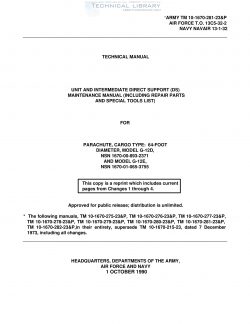ARMY-TM-10-1670-281-23-and-P
- Version
- 421 Downloads
- 3.92 MB File Size
- 1 File Count
- March 5, 2017 Create Date
- March 5, 2017 Last Updated
Parachute, Cargo Type; 64' Diameter, Model G-12D, NSN 1670-00-893-2371 & Model G-12E

2-4. Initial Receipt. The following describes the procedures for processing parachutes upon initial receipt. a. General Procedures for 64-Foot Diameter Cargo Parachute. When air delivery equipment is initially procured from a supply source and issued to a using unit, the item(s) will be unpacked from the shipping container(s) and inspected by a qualified parachute rigger (MOS 43E). The inspection performed will be a technical rigger-type which will be conducted as outlined Upon completion of the inspection, the item(s) will be tagged as prescribed in DA PAM 738-751. Serviceable equipment may then be entered either into storage or into use in air delivery operations, as applicable. An unserviceable item will be held and reported in accordance with DA PAM 738-750. b. Inspection Personnel. Personnel other than parachute rigger personnel may assist in the unpacking process of initially received parachutes as directed by the local air delivery equipment maintenance officer. However, the maintenance officer will insure that the entire unpacking effort is conducted under the direct supervision of a qualified rigger (MOS 43E). c. Configuration Condition. Acceptance of new equipment from the manufacturer is based upon inspections made of sample lots which have been randomly selected in accordance with military standards. It is incumbent upon the using activity personnel to bear this in mind whenever equipment is first placed in service. Changes will sometimes evolve from the original equipment design and sometimes contracts are authorized to make deviations in material and construction techniques. Air delivery equipment that has been in the field cannot be expected to meet exacting manufacturing specifications, however, the equipment should closely reflect desired design characteristics. Since repairs, modifications, and/or changes can alter or detract from the configuration originally desired, such equipment shall be airworthy, safe, of-the desired configuration, and adequate for intended use. d. E.acacåute-LQg-EeGQL.d. The Army Parachute Log Record DA Form 10-42 or DA Form 3912 is a history- type maintenance document which accompanies the- parachute canopy and deployment bag assemblies through the period of service of the individual assembly. The log record provides a means of recording maintenance actions performed on a parachute canopy assembly. Normally, a log record is initiated and attached to a deployment bag upon receipt by a using unit. However, if the item is subjected to alteration or modification by a maintenance activity during the interim period from date of manufacture to receipt by a using unit, the log record will be prepared by the activity performing the maintenance function. Once initiated, a log record will be attached to and contained in an affixed parachute log record/inspection data pocket until such time as the parachute canopy assembly is destroyed or rendered unfit for further use or-repair. Additionally, should an item that requires a log record be transferred from one unit to another, the log record for the parachute assembly will accompany the item in the transfer action. A prepared log record will not be
| File | Action |
|---|---|
| ARMY-TM-10-1670-281-23-and-P Parachute, Cargo Type; 64' Diameter, Model G-12D, NSN 1670-00-893-2371 & Model G-12E,.pdf | Download |

Comment On This Post